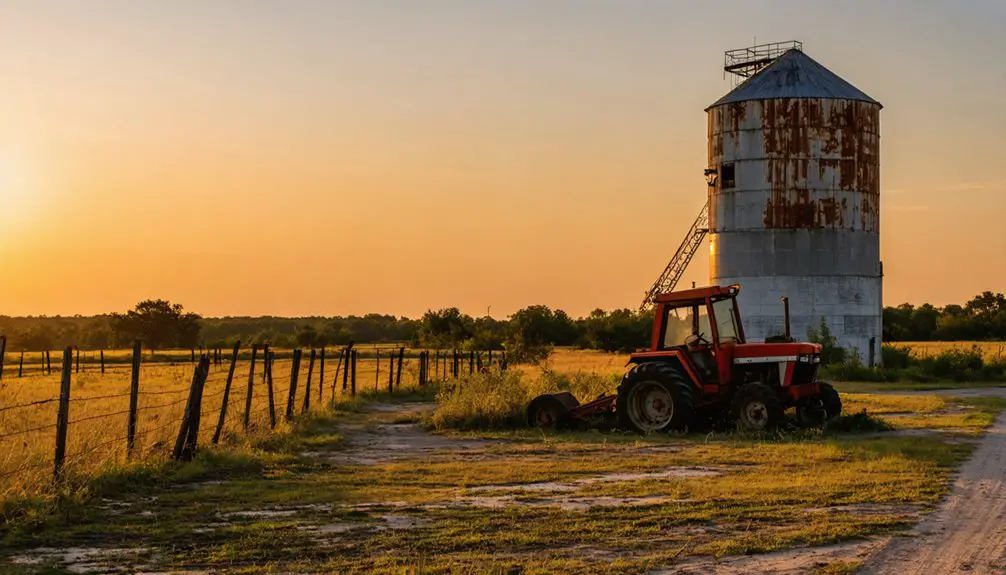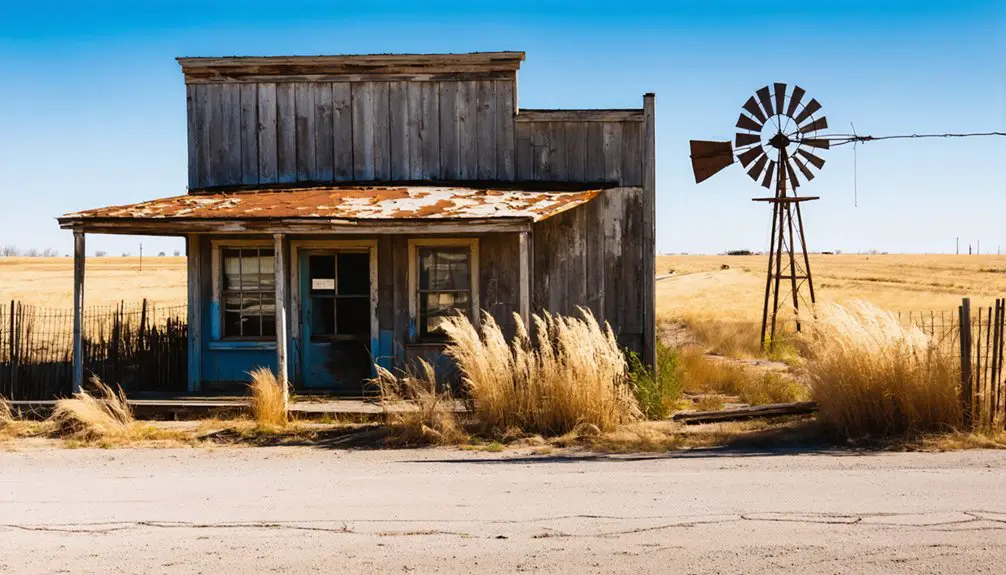You’ll find Bailey, Oklahoma, 12 miles northeast of Marlow in Grady County, where a vibrant prairie settlement once thrived. Established in 1902 on 32.5 acres, the town featured a cotton gin, Methodist church, schoolhouse, general store, blacksmith shop, and drugstore. The post office, opened in 1892, served as a crucial link until 1932. Though Bailey’s buildings now stand abandoned, its story captures the rise and fall of Oklahoma’s early agricultural communities.
Key Takeaways
- Bailey emerged in 1902 as a thriving prairie settlement in Grady County, Oklahoma, located 12 miles northeast of Marlow.
- The town featured essential services including a cotton gin, Methodist church, schoolhouse, general store, blacksmith shop, and drugstore.
- Daily life centered around agriculture, with cotton farming and livestock operations forming the economic backbone of the community.
- The post office’s closure in 1932 marked a significant turning point in Bailey’s decline toward ghost town status.
- Bailey experienced an 80% population decline and widespread business closures, leading to its eventual abandonment in the early 20th century.
The Birth of a Prairie Settlement
When J. J. Bailey served as wagon master on the stage line to Fort Sill, he couldn’t have known the prairie settlement bearing his name would emerge as a monument to Oklahoma’s settlement patterns.
Much like Bəyli in Azerbaijan, Bailey emerged as a testament to human settlement in rugged terrain.
In 1902, surveyors platted 32.5 acres of promise about 12 miles northeast of Marlow in Grady County.
Like the nearby community of Acme Cement, Bailey’s foundations of prairie life quickly took shape as crucial services sprouted on the fertile plains. You’d have found a cotton gin, Methodist church, and schoolhouse anchoring the community, while a general store, blacksmith shop, and drugstore served daily needs.
Two doctors provided medical care, and the post office, established in 1892, connected settlers to the outside world.
The town’s strategic location along transportation routes to military installations proved essential for early growth and commerce.
Life in Early Bailey
As you walked through early Bailey, you’d find daily life centered around the cotton gin and general store, where farmers and ranchers conducted their business and exchanged news.
The Methodist church served as the heart of social gatherings, providing spiritual guidance and a meeting place for the tight-knit prairie community. Like many all-black settlements in Oklahoma Territory, Bailey represented a chance for former slaves to build independent, self-governing communities.
Agricultural seasons dictated the rhythm of town life, with residents coming together for cotton harvests, livestock sales, and community celebrations that strengthened their bonds of mutual support.
Daily Commerce and Trade
Four key businesses formed the commercial heart of early Bailey: a cotton gin, general store, blacksmith shop, and drug store.
Like many communities that established lead-and-zinc mining industries in the early 1900s, early commercial districts became vital economic centers.
You’d find local bartering happening daily at these establishments, where farmers traded cotton and other agricultural goods for essential supplies. The general store served as your primary source for household provisions, while the blacksmith kept your farming equipment and transportation running smoothly.
Like many communities that relied on railroad routing, Bailey’s economic success was closely tied to transportation networks. The town’s trade networks extended 12 miles southwest to Marlow, where you could access larger markets.
Two resident doctors and the drug store guaranteed you’d have medical care and medicines when needed. The post office facilitated business correspondence until 1932, helping you maintain commercial connections beyond Bailey’s 32.5-acre town plat.
Your success in Bailey depended on these interconnected commercial relationships.
Religious and Social Gatherings
The Methodist church stood as Bailey’s spiritual and social cornerstone, where you’d join fellow residents for weekly worship and community gatherings.
After Sunday services, you’d find yourself immersed in fellowship activities, sharing meals and stories with neighbors and extended family.
Beyond religious services, you’d participate in various community events at the local school, including plays, graduations, and educational meetings.
The church and school buildings served dual purposes, hosting everything from revival meetings to adult education sessions. These community spaces helped preserve cultural heritage through organized activities and gatherings.
You’d often gather at informal spots like the blacksmith shop or general store to exchange news and strengthen community bonds.
Local traditions, from holiday celebrations to hymn singing, wove together the fabric of Bailey’s social life, while town meetings gave you a voice in addressing community needs and organizing collective efforts.
Agricultural Community Activities
While faith and fellowship brought Bailey’s residents together on Sundays, farming dominated their daily lives throughout the week. You’d find families working from sunrise to sunset, tending to cotton fields, corn crops, and vegetable gardens that sustained their community.
During peak seasons, community events centered around agricultural activities, with neighbors helping neighbors during harvests and barn raisings. Like many Oklahoma farmers of the era, residents struggled with limited access to modern conveniences, with most relying on traditional manual labor and horse-drawn equipment.
The local general store and cotton gin served as hubs where farming cooperatives gathered to trade goods, repair equipment, and share agricultural knowledge. You’d see farmers exchanging drought-resistant seeds, discussing crop rotation techniques, and bartering supplies.
Children learned farming practices both at home and in school, where the academic calendar adapted to accommodate vital planting and harvesting periods.
Community Pillars and Local Services
During its peak years, Bailey hosted a diverse network of essential services and community institutions that sustained daily life in this Oklahoma settlement.
You’d find the Methodist church serving as both a spiritual center and social hub, while the local school educated the community’s children. The town’s community resilience was evident in its service evolution, with two doctors providing healthcare and a drug store supplying medicines.
The commercial heart of Bailey included a general store, cotton gin, and blacksmith shop, while the post office connected residents to the outside world from 1892 to 1932. The area once represented a thriving black community that operated independently and sustainably.
These pillars of community life gradually disappeared over time, leading to Bailey’s transformation into a ghost town as residents sought locations with better access to essential services.
Agricultural Roots and Economic Foundation

Originally established as a cotton plantation, Bailey’s agricultural foundation shaped its economic trajectory throughout its existence.
Like many ghost town sites in Oklahoma, Bailey’s story reflects the broader pattern of resource-dependent communities that emerged post-statehood.
The ranch suffered fires that tested but didn’t break the resilience of its agricultural operations.
You’ll find that cotton cultivation dominated the early landscape, alongside expansive fruit orchards that showcased the area’s agricultural diversity.
After facing challenges during the Dust Bowl era, the community adapted by shifting to livestock diversification.
During hard times, they showed resilience by moving away from crops and building diverse livestock operations instead.
- The ranch developed an extensive bull breeding program featuring crossbred cattle
- Two regional stockyards in Muskogee and Pryor supported the growing cattle operations
- Over 100 native crossbred cows and separate Angus herds demonstrated ongoing breeding efforts
- A specialized band of bucking-bred mares added to the ranch’s diverse livestock portfolio
The Methodist Church’s Central Role
When you visited Bailey in its prime, you’d find the Methodist church serving as a crucial community hub where both settlers and Native American families gathered for worship and social activities.
The church’s educational initiatives provided essential literacy programs and religious instruction that helped strengthen the growing community.
Through cooperative efforts between Methodist leaders and Indian Mission Conferences, the church fostered important relationships between Native and white settlers while supporting the town’s development through spiritual guidance and social services.
Religious Community Gathering Hub
At the heart of Bailey’s community life stood its Methodist church, which served as both a spiritual sanctuary and social nucleus for the town’s residents. Through faith-based outreach and cultural integration, the church fostered connections between settlers and indigenous peoples, creating a unified religious community that transcended cultural boundaries.
You’ll find the church’s impact extended far beyond Sunday services:
- Provided essential social welfare support to struggling families during difficult times
- Served as a central meeting place for local decision-making and community gatherings
- Hosted seasonal events and celebrations that strengthened social bonds
- Facilitated interactions between itinerant preachers and local congregants
The Methodist church’s influence helped shape Bailey’s identity, offering spiritual guidance while maintaining strong ties to regional Methodist conferences and indigenous missions throughout Oklahoma.
Church’s Educational Activities
The Methodist Church’s influence in Bailey extended well beyond spiritual guidance into formal education, establishing itself as a cornerstone of learning in the community.
You’ll find their educational impact was particularly significant in bridging cultural gaps between Native American communities and white settlers through extensive programs that combined academic instruction with religious teachings.
The church’s community engagement included partnerships with both U.S. government initiatives and Indian National Councils, creating a unique educational framework that served Cherokee, Choctaw, and Creek populations.
Through their Methodist Indian Mission Conference, they trained local Indian preachers and developed indigenous leadership within the church.
This dual approach of spiritual and academic instruction helped establish a strong foundation for cross-cultural understanding while fostering the development of “distinctly Indian congregations” with educational components.
Medical Care and Commerce

Despite its small size, Bailey maintained a robust medical and commercial infrastructure that included two practicing physicians, a drug store, and various essential businesses during its peak years.
You’d find basic healthcare access through private practices, while the drug store supplied medical supplies and pharmaceuticals for the community.
The town’s commercial significance centered around several key establishments:
- A general store providing daily necessities and serving as a community hub
- A cotton gin processing local agricultural products
- A blacksmith shop maintaining pivotal farming equipment and transportation
- A post office (1892-1932) facilitating regional trade and communication
You’ll note that Bailey’s economic foundation rested firmly on agriculture and its supporting businesses, though the town’s eventual decline mirrored the fate of many rural Oklahoma communities affected by mechanization and shifting transportation routes.
The Post Office Era: 1892-1932
When Bailey’s first postmaster took office in 1892, you’d find a bustling communication hub that would serve the community for four decades. You could send letters, conduct business, and stay connected to the outside world through this essential outpost in Grady County.
The postal evolution brought federal oversight and modernization, while the office remained a cherished gathering spot where you’d catch up on local news.
As communication changes swept through rural Oklahoma, you’d witness the gradual transformation from horse-drawn mail routes to early motorized delivery.
The Great Depression and the rise of telephone services ultimately weakened the post office’s role. By 1932, Bailey’s postal chapter closed, marking the end of an era that had helped define the community’s identity since territorial days.
Signs of Decline and Abandonment

As Bailey’s primary industries faltered in the early 20th century, you’d notice telltale signs of the town’s impending decline.
The population patterns followed a familiar trajectory seen in many Oklahoma ghost towns, with economic decline accelerating as residents sought opportunities elsewhere.
Transportation changes, particularly the rerouting of major roads, left Bailey increasingly isolated from crucial commerce routes.
The town’s deterioration became evident through:
- Shuttered businesses and abandoned storefronts along main thoroughfares
- A dramatic population drop exceeding 80% from peak numbers
- The closure of essential services, including the post office in 1932
- Neglected infrastructure falling into disrepair due to lack of maintenance
Cultural factors and environmental disruptions further hastened Bailey’s abandonment, transforming a once-thriving community into another Oklahoma ghost town.
Legacy in Oklahoma’s Rural History
Through its forty-year existence, Bailey established a significant footprint in Oklahoma’s rural history, particularly as one of several African American settlements that emerged during the territorial period.
You’ll find Bailey’s story intertwined with themes of rural resilience, as its residents built a self-sufficient community complete with a cotton gin, Methodist church, school, and essential businesses.
Like other African American communities such as Lincoln, Cimarron City, and Zion, Bailey represented a bold experiment in economic advancement and racial solidarity.
While the town no longer appears on modern maps, its legacy endures through its contribution to Oklahoma’s cultural heritage.
The community’s determination to create an independent, thriving settlement despite prevalent racial challenges exemplifies the pioneering spirit of early territorial settlements.
Frequently Asked Questions
Are There Any Remaining Artifacts From Bailey in Local Museums?
You won’t find Bailey artifacts in local museums, as research shows no documented collections featuring items from this ghost town in Oklahoma’s Route 66 Museum or other regional historical institutions.
What Natural Disasters or Severe Weather Events Affected Bailey’s Development?
Ever wonder what forces of nature shaped Bailey’s fate? You’d find drought impact severely affected cotton farming and livestock, while flood consequences near the South Canadian River disrupted transportation and commerce, hindering the town’s growth.
Who Was the Last Resident to Leave Bailey?
You can’t definitively identify Bailey’s last resident, as historical records don’t document who made the final departure, though most residents likely left after the post office closed in 1932.
Did Any Notable Outlaws or Lawmen Have Connections to Bailey?
You won’t find any notable outlaws or lawmen with historical connections to Bailey. Records don’t show significant law enforcement presence or outlaw activity in this small farming community’s history.
Were There Any Native American Settlements Near Bailey Before Its Establishment?
You’ll find the Osage Nation maintained the strongest presence near Bailey, with their native tribes’ settlement patterns including seasonal camps and hunting grounds in the north-central Oklahoma region they called home.
References
- https://en.wikipedia.org/wiki/Bailey
- https://kids.kiddle.co/Bailey
- https://en.wikipedia.org/wiki/List_of_ghost_towns_in_Oklahoma
- http://genealogytrails.com/oka/grady/towns.html
- https://www.wikiwand.com/en/articles/Bailey
- https://www.baileyranchok.com/about
- https://nondoc.com/2019/07/25/oklahoma-historic-all-black-towns/
- http://www.african-nativeamerican.com/6-towns.htm
- https://www.okhistory.org/publications/enc/entry?entry=GH002
- https://www.okhistory.org/publications/enc/entry?entry=CO037



